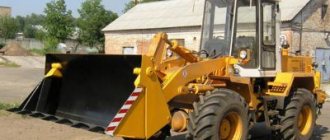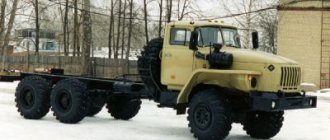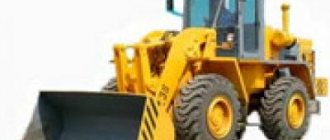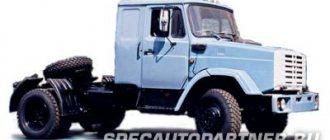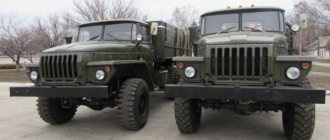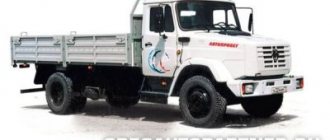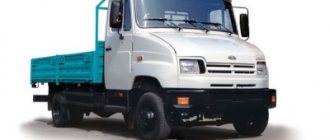For questions regarding the purchase of this equipment (PAZ-4230-01 Aurora bus), terms of credit and leasing, service and warranty, please contact the plant’s dealers or official representative offices. Delivery of PAZ-4230-01 Aurora bus can be carried out either directly from the manufacturer or from sites in Moscow and other regions of the Russian Federation.
History of creation
At the end of the 1990s, the Pavlovsk Bus Plant faced the need to restructure production in order to produce a wide range of buses of different classes. Before this, PAZ specialized only in the production of small class buses. The flagship model at that time was the PAZ-3205 bus. In this regard, PAZ developed the large PAZ-5271, PAZ-5272 and medium-class PAZ-4230 “Aurora” models . The new Pavlovsk bus attracted close attention and received many awards at exhibitions.
Since 2000, PAZ began to establish production for the production of a new model of the PAZ-4230 Aurora bus. At the same time, PAZ was attached to the management. In 2001, the Pavlovsk Automobile Plant began serial production.
Bus PAZ-4230 Aurora. Photo Wikipedia
In 2001, the Kurgan Bus Plant entered the. To prevent intra-corporate competition, it was decided that KAvZ would specialize in the production of middle-class buses for urban and suburban use. As a result, production of the PAZ-4230 Aurora bus was transferred in 2002 to the Kurgan Bus Plant.
After carrying out all the necessary measures to prepare production and train personnel, in 2003 KAvZ began serial production of the PAZ-4230 Aurora bus. At first, two modifications of buses PAZ-4230-01 and PAZ-4230-02 were produced, respectively, suburban and intercity versions. The production of the urban modification PAZ-4230-03 was mastered by KAvZ at the end of 2005. In 2006, a new extended model PAZ-4238 “Aurora” appeared, which was intended for operation on urban, suburban and intercity routes over a distance of up to 500 km.
In 2008, KavZ specialists developed the KavZ-4235 model, in connection with the introduction of environmental regulations and tightening standards for emissions of harmful substances into the atmosphere, which replaced the PAZ-4230 model on the conveyor. In 2010, a school modification based on the KAvZ-4238 Aurora was created and certified. In 2010, the plant restyled the exterior of the base model, as well as modernized the power structure of the body, the interior of the bus, the heating system and the braking system.
PAZ 4230 - selection of materials, prices, links, photos and videos | Buses
Category: Buses
PAZ 4230 - a selection of materials, prices, links, photos and videos about the car
How much does PAZ 4230 cost?
Average price of PAZ 4230 in Russia: price is temporarily unavailable.*
*Based on analysis of information from the Yandex Auto website
Photos of the PAZ 4230 car:
Description: Tags: PAZ 4230-01 Aurora | Description: Bus PAZ-4230 “Aurora” | Description: Tags: PAZ 4230-03 Aurora |
Description: Tags: PAZ 4230-01U Aurora | Description: PAZ-4230-01 (-04) Aurora431 |
Links to materials about the PAZ 4230 car:
PAZ
-
4230
"Aurora" - Wikipedia
GROOVE
—
4230
“Aurora” is a medium bus developed in the late 1990s at the Pavlovsk Bus Plant.
Since 2001, PAZ has established... Link:
https://ru.wikipedia.org/wiki/PAZ-4230_Aurora Pavlovsk bus - Wikipedia
Due to the greater market demand for small buses, the medium PAZ
—
4230
did not become the main model of the plant.
Its modification KAvZ-4238 according to ... Link:
https://ru.wikipedia.org/wiki/Pavlovsky_busEngine D-245.9E2-397 Bus
PAZ 4230
Aurora - YouTube
25 Jan 2014 …
On the website https://WWW.d245.ru you can always get acquainted with the assortment, equipment and leave a request for...
Link:
PAZ 4230
-03 Aurora Photos of buses
Bus PAZ
—
4230
-03 middle class is designed for suburban and intercity transportation.
The bus is the embodiment of modern... Link:
https://www.omnibus.ru/photos/paz/4230-03_avrora/
groove 4230
Aurora - YouTube
7 Nov 2012 ...
groove 4230
Aurora.
Nikita Monks... Uni-Block Petrozavodsk Disassembling the groove by alex bird 9,213 views; 10:48. Watch Later UAZ. moving... Link:
https://www.youtube.com/watch?v=kO45rqTeShISales
of PAZ 4230
-02 in Ukraine - Ria.com
RIA.com - Buy or sell PAZ 4230
-02 (PAZ 4230-02) in Ukraine, all advertisements for the sale of cars - buy a used PAZ 4230-02 or advertise for...
Link:
https://auto.ria.com/car/paz/4230-02/
Video about the PAZ 4230 car:
groove 4230 Aurora
PAZ-4230-03 (its 304 26) Pyatigorsk
PAZ-4230
PAZ 4230 Aurora 27 07 14
Engine D-245.9E2-397 Bus PAZ 4230 Aurora
Detailed description, device
There are three basic options: “4230-01”, “-02” and “-03”. Buses with the indexes “-01” and “-02” are intended for suburban and intercity transportation, respectively. Both versions have single-leaf sliding doors . The doors are opened by a rotary pneumatic cylinder Knorr-Bremse (Germany). The salon has a four-row seat layout , the aisle between them is not wide.
The seats on both cars are separate , arranged in pairs and installed on low longitudinal podiums running along the entire body. The podiums made it possible to place luggage compartments with a total volume of 1.75 cubic meters under the bus floor; access to them is provided from the outside, through the side hatches.
The cabin also has longitudinal luggage racks for small items; Interior lighting lamps are built into the vertical mounting posts of the luggage racks (there are 10 of them in total). The suburban Aurora has soft seats with a fixed backrest and fabric upholstery . An intercity car has aircraft-type seats with a reclining backrest and an armrest. The total number of seats for the suburban Aurora is 31, while the intercity one has 29 (there are 5 rows of seats on the right instead of 6). On both buses, all seats are located along the direction of the car. The interior is ventilated through two hatches in the roof and through narrow windows that fold inward (the side windows of these modifications are glued in). As for the hatches, they are manufactured by the Finnish company Parabus.
Suburban bus PAZ-32053/54. Photo GAZ
“Aurora” with indexes “-03” (similar to “-01U”) are modifications for city routes. Their doors are not sliding, but folding, double-leaf . They are similar in design to the doors installed on the PAZ-32054. There are no luggage racks in the cabin - instead, two upper longitudinal handrails are installed, the brackets of which are attached to the ceiling. Thanks to the absence of luggage compartments, the floor in the cabin was able to be made level across the entire width of the cabin, without podiums under the seats. For a city bus, in which passengers get up and sit down much more often, the absence of an extra step is a big plus.
The PAZ-4230-03 has separate seats, similar to those installed on the PAZ-4230-01, but with simpler upholstery, made of leatherette. The layout of the interior, due to the wheel arches, which made themselves felt when the podiums under the seats were removed, changed as follows. The double seats , three on either side, retained their location inside the wheelbase, as well as on the left in front of the rear door. The front wheel wells are masked on the right with single back-to-back seats, and on the left with three seats rotated 90° and arranged in a row. The rear wheel niches are covered on the right by a conductor's seat (with seating across the passenger compartment), on the left by a double seat with seating facing the rear of the vehicle.
the PAZ-4230-01U modification are simplified, similar to those on the PAZ-32053: two-seater sofas with a common back and a pillow on both sides, located along the vehicle on the left in seven rows, on the right in 6 rows. The side windows on the Aurora “-03”, “-01U” can be either glued or regular, inserted with rubber seals. Accordingly, the windows of the former are folding, while those of the latter are sliding. The interior lighting is provided by six longitudinal ceiling lamps arranged in 2 rows. Another distinctive feature of the Aurora that catches your eye when you first look at the bus: the rear-view mirrors are mounted on conventional brackets, unlike the cantilever mirrors of buses of modifications “-01” and “-02”.
VIP class modification of the Aurora . Externally, it can be unmistakably recognized by the modified design of the “face” and tinted side windows without windows. There are two Webasto air conditioners on the roof with a total power of 16 kW. There are also differences that are not noticeable from the outside. Instead of the standard Aurora engine MMZ D-245.9, a Cummins D180 is installed. The capacity of the fuel tank (from 105 to 200 l) and luggage compartment (up to 2.8 cubic meters) has been increased.
Bus PAZ-4230 Aurora. Photo Wikipedia
The cabin is equipped with highly comfortable aviation-type seats The interior layout is standard: two seats on the right and left, only there are not five, but four seats above the engine compartment. Each passenger seat is equipped with individual lighting and air conditioning outlets. An audio/video system is also standard on this modification. In general, the level of equipment of the salon with expensive “bells and whistles” depends only on the imagination and solvency of the customer.
Buses PAZ-4230 "Aurora" and PAZ-32053
A. Erokhin, photo by K. Ushanov
Related link: "Aurora", but not a cruiser
At the end of April, two Pavlovsky and PAZ-32053 buses appeared at the test site in Dmitrov. Given the interest of readers, we secured consent and took these machines for editorial tests. Since we had to fit into the factory testing program, the buses could only be tested with a full load.
So, let's start in order. The exterior of the PAZ-4230 “Aurora” looks more attractive compared to the previous model PAZ-32053, but let’s say a few words about some things that seemed not entirely successful. As you know, Pavlovsk buses traditionally operate not only on paved roads, but also where the asphalt ends. Recently, in some cities they have found widespread use as minibuses. The presence of large overhangs on the Aurora greatly limits its scope of application, and this vehicle cannot be considered as a successor to the good old PAZik. It is clearly not as well suited for driving on dirt roads as the PAZ-32053.
| Old friend ZMZ-523400 |
The Aurora salon is designed for 31 seats. The seats for passengers are upholstered in fabric with a pleasant pattern. With the doors located at the front and rear, the interior created a very long passage. The good thing is that it is not as narrow as some other commuter buses. It seems to us that the optimal place for the rear door is closer to the rear third of the cabin, like most German buses, although with such a base and overhangs it will be almost in the middle of the cabin.
The interior of the old PAZik is shorter than that of the Aurora and is equipped with one main door. The second, back door is an emergency exit. Due to its shorter length, the passenger capacity of the PAZik is somewhat less.
The driver's seat in both cars, using the existing set of adjustments, allows you to sit quite comfortably at the workplace. The presence of seat cushioning makes the seating more comfortable. Of course, a modern air-suspended seat with a more complete set of adjustments would be more comfortable, but, unfortunately, all this affects the price. For a comfortable fit, I would like to have an adjustable steering column.
| PAZ-32053: The battery is located on a retractable platform |
The indicator lamps on the instrument panel are located within the visible range and are not blocked by the steering wheel. But when the panel is brightly lit, for example, on a sunny day, it is very difficult to notice the burning indicator lamp. The same can be said about the MAZ-32053. By the way, this is a disease of many domestic cars. Using the pedals does not cause any difficulties on both cars.
The gear shift drive on the Aurora is far from being made in the best possible way. When using the lever, we had problems selecting gears. On the “32053” there are also plenty of problems with selecting and shifting gears, and the very short shift strokes are surprising. You can guess when a gear is engaged at the level of an abrupt change in force on the gearbox lever.
Unfortunately, we can’t say anything about the interior heating, and the test was carried out on a nice spring day, it was +15 degrees outside.
| The driver’s workplace in the Aurora is quite comfortable |
The maximum speed of 88.4 km/h - we obtained this value during measurements testing the Aurora, is quite enough for a commuter bus on Russian roads, although the declared maximum speed is higher. Acceleration dynamics at full load are at an acceptable level. On smooth surfaces, we had no complaints about the 5-speed gearbox, but when driving on roads with slight inclines, we really wanted to have “halves” of gears on hand. Perhaps this is due to the fact that you don’t want to once again use such an unruly lever with a cable drive to control the box.
The selection of gear ratios for the Aurora transmission is more typical for a commuter bus; on the PAZ-32053 it is probably similar.
The fuel efficiency indicators of the Aurora are at a very good level, but the speed indicators look noticeably worse. Apparently, this is due to incorrect adjustment of the fuel supply control drive. In fact, maximum engine power is achieved at 2,400 min-1, and on our car the speed limit occurs already at 1,900 min-1.
| The place for the first aid kit is very convenient |
In the instrument cluster of the “053rd” PAZik we were pleasantly surprised by the presence of a tachometer. As far as we know, no one has installed tachometers on cars that use ZMZ-523400 engines (ZMZ-53 is the former name of the engine).
The fuel efficiency of the PAZ-32053 bus is significantly worse. There is no need to say anything on this topic, since no one (except Pavlovsk residents, of course) has installed a carburetor engine on such a car for a long time.
If we compare the fuel consumption of buses, then, despite the greater weight (almost 2,350 kg) and almost the same maximum speed (the difference in speed is 1.2 km/h), the Aurora has 8.7 l/100 km less than PAZ-32053. This is 26%. A solid advantage, isn't it? In terms of dynamics, the Aurora is also slightly better than the PAZ-32053. In fact, the average speed on a standard route simulating city traffic is almost 2 km/h higher.
| No comments |
It’s nice that both buses are equipped with an anti-lock brake system as standard, which significantly increases the passive safety of the vehicles. But it’s a pity that there is no traction control system, which would also be useful on buses, especially in winter.
To summarize, we can say the following: the new model is better than the previous one and significantly more economical to operate. In general, given the large shortage of buses, we liked the cars, and we are confident that they will definitely find, or rather, have already found, their place in the market.
The editors thank the management of the holding company and representatives of Pavlovsky Bus OJSC for the cars provided for the test.
www.gruzovikpress.ru
Basic information, characteristics
Manufacturer/manufacturer where the equipment is produced/manufactured. Pavlovsky Bus is a Soviet and Russian manufacturer of small and medium class buses. Located in the city of Pavlovo, Nizhny Novgorod region. Part of the GAZ group. Since 2005, bus production has been carried out by PAZ LLC, a 100% subsidiary of Pavlovsky Bus PJSC.
Purpose. Urban, suburban, intercity.
Class. Average.
Body type. Carrier, carriage layout.
Body resource. 8 years.
Operating manual KAVZ-4235
The Kurgan Automobile Plant is known for hooded buses on the GAZ chassis, which were produced for about 50 years, until 2007. These machines have proven themselves to be excellent. Unpretentiousness, maintainability, low price of the finished bus and spare parts for it - these are the main advantages of this equipment. And in 2003, production of the Aurora model (PAZ 4230) was transferred to KaVZ from PAZ, which in its new location received the KaVZ index 4235. After all, both enterprises are part of the Russian Buses holding. Based on the KaVZ-4235, the 4238 model was developed and put into production. It is different in length - 1.2 meters longer, which makes it possible to operate such a bus on busier routes.
Specifications
Bus PAZ-4230 Aurora. Photo Wikipedia
Fuel type. Diesel.
Fuel tank capacity. 105.
Curb and technically permissible weight, kg. 7070 and 11040; 7110 and 10940; 6920 and 10975.
Load on front/rear axle based on technically permissible weight, kg. 2330/4740; 2340/4770; 2240/4680.
Minimum turning radius, m. Along the track axis of the front outer wheel and along the outer extreme point of the body, 7.6 and 8.7.
Front approach angle/rear departure angle, degrees. 10 / 9.
Steering gear. MAZ, 64229 “screw-nut-rack-sector”.
Steering type. With hydraulic booster.
Brake system. Working - pneumatic, dual-circuit, divided into circuits along the axes, drum brakes on all wheels, ABS.
Parking - drive from spring energy accumulators to the brake mechanisms of the rear wheels.
The spare is one of the circuits of the service brake system.
Spare parts catalog for KAVZ AURORA 4235 (2006 - BC) (ISBe 150)
Select the required section
- Maintenance parts Adjustment interval
- Additional work
- Gaskets Cylinder head gasket
- Cylinder head gasket
- Camshaft
- Crankshaft Crankshaft bearing shell
- Connecting rod lower head shell
- Oil filter
- Oil filter
- Sensors
- Clutch pressure plate
- Mixture preparation Nozzle valve / nozzle / nozzle rod / PDE
- Pump/accessories Fuel pump
- Installation details Mounting elements Clamp
On our website you can buy custom auto parts at a low price. To make the right choice of spare parts for KAVZ AURORA 4235-ISBe 150 in the Nolder online store catalog, it is advisable to have a registration certificate with you. This document provides all the necessary information about your car.
The main parameters used from the certificate when searching for parts are presented below:
- Make, model: (for example: KAVZ AURORA);
- Engine power, kW/hp (for example - 250 hp);
- Year of vehicle production: (for example: 2011);
- Identification number (VIN): (for example: XUFRE567HY1238877).
- Knowing the VIN of your car, you will never go wrong with your purchase.
Also, for the correct selection of auto parts, you need to know the engine size and its code. These parameters are located in the PTS.
Delivery is carried out by courier in Yekaterinburg, as well as by a transport company to other cities of Russia.
Source
Chassis characteristics
Brand. RZAA.
Main bridge. Rear.
Wheel formula. 4x2.
Wheelbase, mm. 3600.
Ground clearance/ground clearance, mm. Small.
Clutch type. Single-disc diaphragm, hydraulic clutch drive with pneumatic booster.
Tires and wheels. For models 4230-01, 4230-02: disc 6.0-20 on 8 studs, tires 8.25/R20; for models 4230-03: disc 8.25-22.5 on 10 studs, tires - 11/70R22.5.
Anti-lock braking system (ABS). Present.
Modifications[ | ]
- PAZ-4230-01
"Aurora" - suburban - PAZ-4230-02
"Aurora" - long-distance - PAZ-4230-03
"Aurora" - urban - PAZ-4230-01U
"Aurora" - simplified suburban - PAZ-4230-01K
"Aurora" - luxury suburban class
- KAvZ-4235
"Aurora" - urban, suburban - KAvZ-4235-31
"Aurora" - suburban - KAvZ-4235-32
"Aurora" - long-distance - KAvZ-4235-33
"Aurora" - urban[6]
Engine/powertrain characteristics
| Options | Cummins ISBe 150.31 | MMZ D-245.9 |
| Type | Diesel engine | Diesel engine |
| Number and arrangement of cylinders | 4R | 4R |
| Environmental safety standards | Euro-3 | Euro 1-5 |
| Working volume, l | 3,9 | 4,75 |
| Engine power, kW (hp)/min | 110 (150) | 136 l. s., at 2400 rpm |
| Max. torque, Nm/min | 550 (at 1300) | 465 Nm, at 1600 rpm |
| Engine location | Rear, longitudinal | Rear, longitudinal |
| checkpoint | ZF 56S600B0, mechanical, 5-speed | PAZ-3206-70 (SAAZ), mechanical, 5-stage. |
| Maximum speed, km/h | 110 | 90 |
| Front-rear axle suspension | spring-spring | spring-spring |
| Control fuel consumption at 60 km/h, l/100 km. | – | 25 |
How to adjust the gear shift drive
The occurrence of any problems with gear shifting does not always mean a serious breakdown of the gearbox. If gears are difficult to engage, difficulties have arisen with selecting a gear, which prevents engagement, etc., then in some cases it is sufficient to adjust the gear shift drive. At the same time, you can adjust the manual transmission drive either at a service station or independently.
Read in this article
- Adjusting the gear shift drive
- What's the result?
Adjusting the gear shift drive
Before regulating anything, you need to have an idea of how this or that mechanism works, how it works, etc. First, let's look at the design and principle of operation of a manual gearbox (gearbox) in general terms.
The gearbox converts and transmits torque from the engine to the drive wheels so that the car can move off and change speed. There are four types of gearboxes: manual, automatic, robotic and CVT.
The first two types are the most common today. Taking into account the fact that a manual transmission or “mechanics” has a simpler design, we will consider just such a unit as an example.
A mechanical transmission is, relatively speaking, a set of shafts (input and output) and a set of gears on each of the shafts. The gears on the shafts mesh and thus interact with each other.
Using the gear shift lever, the driver can determine which pairs of gears will work, that is, select the desired gear. At the same time, on a manual transmission you also have to depress the clutch so that the torque is not transmitted to the gearbox (to the input shaft).
Like any other mechanism, the shift drive has certain settings that get lost over time. This may cause problems with transmission control. In other words, if the gears are difficult to engage, there can be many reasons, one of them being the need to adjust the drive.
We also recommend reading the article about what a gearbox yoke is. From this article you will learn about the purpose, design, principles of operation, as well as signs of problems with the mechanism and how to adjust the gearbox rocker if necessary.
By and large, all adjustment of the gear shift mechanism in a garage comes down to working on the gear selection rod. It is also called the backstage. In a nutshell, the linkage is the device that connects the gearshift lever to the gearbox. When it wears out, problems arise such as:
- increase in shift lever play;
- incorrect gear selection (another one is switched on instead of the selected one);
- when switching you have to put in more effort than before;
- Extraneous sounds occur when the lever moves.
If the described problems occur, it may often be necessary to completely replace or adjust the linkage.
At the same time, the procedure for setting up the scenes is not complicated. The main thing is to know how to adjust the drive. General recommendations will be given below, as some nuances may arise depending on the make and model of the car. To adjust the gear shift rod you will need the following tools:
- 12 socket wrench;
- pliers;
You can adjust it in two simple ways. There will be one common action for them: loosen (and then tighten again) the rocker clamp. Its location may vary depending on the model and make of the car (you can check it in the manual).
- In reverse gear. The method allows you to solve the problem of incorrect activation of speeds in the vast majority of cases. It consists in the fact that after loosening the clamp (you will need a key for this), reverse gear is engaged (with the engine turned off, in compliance with safety precautions). The shift lever is set to the desired position and the clamp is tightened again.
- Also, gear shift adjustment can be carried out in first gear. To do this, you need to turn it on and then loosen the clamp. Next, the rocker drive is rotated clockwise until the gearbox selector hits the plastic stop of the reverse gear. It feels good. Then the clamp is tightened again, after which the adjustment can be considered complete.
What's the result?
As you can see, problems with gear shifting do not always mean that expensive or major gearbox repairs are necessary. In many cases (if there are no other signs and reasons), it is enough to know how to adjust the gearbox, that is, the linkage on a manual transmission. However, you can perform this procedure yourself.
Finally, we note that with regard to automatic transmissions, even taking into account the fact that such a box has a complex design, you can also configure the automatic box. We also recommend reading the article on how to adjust the automatic transmission cable. From this article you will learn about why adjusting the automatic transmission cable is needed, as well as what results and changes in the operation of the automatic transmission can be achieved through this adjustment.
In this case, correctly adjusted automatic transmission cables allow you to get rid of jerks and kicks of the automatic transmission, as well as achieve smoothness and precision during gear shifting.
KAVZ 4235
We offer new KAVZ Aurora buses for urban and suburban transportation, as well as spare parts and additional options for them.
• New buses from the parking lot in Moscow and on order; • Original spare parts and consumables; • Affordable prices; • Official guarantee; • Maintenance and repair in our own technical center; • Sales on credit; • Leasing for legal entities; • Purchase of your equipment under the Trade-In program; • Discounts for selling multiple machines and repeat orders.
KAVZ 4235 Aurora is a new high-floor bus for organizing transportation in small cities. Depending on the modification, the bus can carry from 52 to 54 people, including from 29 to 31 in comfortable seats.
The body of the KAVZ Aurora is load-bearing, carriage-type, completely metal. The side windows are glued in: this made it possible to abandon the usual side pillars on PAZ buses, improve visibility for passengers and make the design of the bus more modern. The bus has a high floor, under the high floor there is a spacious luggage compartment/
At the moment, the bus is equipped with only one engine - YaMZ 5346 of Euro-5 standard. This version of the YaMZ 534 was developed specifically for the KAVZ 4235. It is a joint development of the Yaroslavl Motor Plant and the Austrian company AVL List GmbH. YaMZ 534 is a fairly simple and reliable engine with a cast iron block and cylinder head. The engine service life before overhaul is 600,000 km; scheduled oil changes are carried out every 30,000 km.


